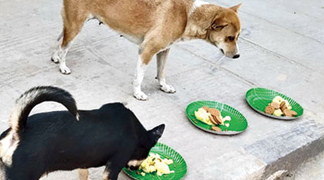Temperatures seem to be soaring every day now and it is equally uncomfortable for our canine friends as it is for us. However, with a little thought, summers can be fun and exciting too if we take the heat out. By taking a few precautions, our furry friends can enjoy summer. All the summer sports and activities can only add to their fun and bonding with us.
Hydrate hydrate and hydrate
Plenty of fresh and cool water must be available for your fur buddy. Whether your pet is staying at home playing in the backyard or going out with you, clean water must be accessible . If you are heading out, buy a portable collapsible water bowl and give small amounts of water at frequent intervals. You can also add ice cubes whenever possible to their water bowels. Also, our canine friends generally have a habit of knocking over their water bowl and sitting on the wet floor, so whenever leaving them alone it must be made sure that the bowls are anti-skid.
Fun with water

Sourced by the correspondent
Outdoor summer activities with your best friend that involves sprinklers, pools or lakes can be really fun and refreshing for them. If you have the means, you can also provide them with a small-kid sized pool to splash into because they say a cool dog is a happy dog in summer. Otherwise, you can use a hose pipe as well to gently spray cool water of them. It may take a few tries but if everything goes well they will definitely feel much rejuvenated after their sprinkler bath.
Watch the outdoor time

Sourced by the correspondent
The mid-day heat with high humidity should be avoided at all costs for going out or for physical activities. Early mornings and evenings are ideal time to go out for walks or have playing sessions during summer. Even the time of exercise sessions should be limited during summer days as our fur buddies already loose a lot of energy in keeping themselves cool. If you have to go outdoors, leaving your pet home and restrict them to rooms with fans or coolers and good ventilators. Do not lock your dog in the balcony or roof as that also subjects to animal cruelty under PCA act.
Parked cars — A strict NO NO
Never ever keep your canine friends inside a parked car, even windows rolled down. Even on milder days, temperature inside can quickly rise and become life threatening for them. Cars parked in indirect sunlight can also have almost double internal temperature. It takes only a few minutes for them to develop a heat stroke and suffocate in a car. The best thing is to keep them home when you are heading out, with plenty of fresh water available but if there is no other option available, you can make them travel with the car’s AC on, provide drinking water often and taking them with you whenever you are parking the car.
If you notice any fur kid locked inside a parked car, promptly inform the parking lot authorities or shopping mall authorities; if the owner doesn’t respond quickly you can inform the cops and local animal welfare too.
Know the signs of heat strokes in dogs
Always keep an acute check on your companion’s behaviour, body language and other activities, specially when out. You must pay attention to their expressions and understand the importance. If your dog suddenly starts holding back on a walk or run that’s his way of telling you that he needs a break. Another way they express is with their ears and tails. Keep an eye whether they are erect and wiggly or have started to droop as these are warning signs. They can’t come and tell you when they are not feeling well so you will have to be extra careful and keep an eye out for worrying symptoms like:
• Excessive salivating
• Visible discomfort and sudden / weird change in behaviour
• Disorientation
• Seizures
• Breathing difficulty
• Rapid heart beat
• Dizziness
Heat stroke causes severe central nervous system disturbances and is often associated with multi-organ dysfunction. You will be able to see visible changes in his/her behaviour. Once you notice any of these symptoms immediately take your pet under a cool shade and offer sips of cool water and if he/she does not show signs of improvement in a few minutes rush to your nearest pet clinic ASAP.
Keep your house cool and refrain from dog house

Sourced by the correspondent
Dog houses often don’t allow for airflow, which makes them a bad choice in the summer heat so avoiding them is the best option. But if dog house is the only option available, make sure to keep the house under a cool shade. Buy a dog house with proper vent holes, which will provide essential airflow. Also you can install insulation in your dog house with foam panels, which gives protection both in summer and winters. Inside the dog house, self-cooling pads are a must, they are a life saver.
Check the pavement
Before heading out for walk or regular exercises, touch the pavement and if it’s too hot for your hand it’s too hot for your dog’s paw pads. Avoid walking on sand and asphalt, walking on grass is much safer.
Food and treats

Sourced by the correspondent
You can help you fur buddy chill from inside out. Make sure to feed him/her with a well-balanced nutritionally complete and energy-dense diet. Dogs tend to eat less in summer but they spend more energy in an effort to lower the body temperature. It is okay for them to eat less... be sensitive in periods of hot weather and trust their ‘decision’ unless they stop eating altogether.
The more the temperature rises, the more energy they need to keep themselves cool. Dogs don’t sweat like us and can only eliminate the excess heat by panting and through their paw pads,which requires a lot of energy thus diet is extremely important. Try to feed fresh home-cooked meals with cool meat protein. You can add veggies like bottle gourd, pumpkin, green papaya to their food; these vegetables are high in water content and extremely beneficial for your pooch.
You can make some cool treats too. Put some chicken stock in the ice tray along with a few boneless chicken pieces and once frozen, serve them straight away or with rice. Or you can give frozen fruit treats too. Fruits like cucumber,watermelon, bananas make a great treat. Cut them into small pieces and mix with unsalted and unsweetened yoghurt and serve them frozen to your canine friend. Another lip-smacking treat recipe is mashing a few pieces of banana with homemade peanut butter and serving them after freezing. These fruit treats act as great antioxidant too; another great source of antioxidant is coconut water. You can also serve little bit of yoghurt with their meals, which acts as a good source of probiotic. But every meal, treat and veggies should be given in small portions and remember not to overdo anything. Dogs tend to ask more of what tastes good to them but we need to keep balance.
Proper Grooming
During summers or in fact any season, grooming is very essential. Maintaining basic hygiene can prevent many diseases. If your pet has long hair get rid of any tangles. Don’t shave your pet’s fur and consult your vet before clipping the fur as while the fur keeps them warm in winter may also keep them cool in summer. Brush them regularly to avoid mats and removal of dead hair. Give them a bath with proper dog shampoo once in a fortnight to avoid fungal infections. It’s best to consult your vet regarding the type of shampoo and frequency of bathing as it varies from breed to breed.
Seasonal Dangers
During summer there are a number of seasonal dangers that you should look out for apart from heat strokes, like ticks, fleas and mosquitoes. These are the troubles all rife through the warmer months and can cause problems. You can try keeping them at bay by maintaining basic hygiene both of the pet and the house by using various flea and tick treatments available but make it a point to consult with your vet before using anything on your pet. Apple cider vinegar and neem oil/water can be used in moderation to repell ticks, fleas and mosquitoes as they also keep skin issues at bay. Viral diseases like parvo, distemper etc flare up during the onset of summer so keeping the shots upto date is extremely necessary as these diseases are fatal.
Exotic Breeds
It is extremely important to research about the suitable climatic condition required for a particular breed before bringing them home. Illegally importing foreign breeds who are clearly not meant to be bred in hot and humid climates not only adds to the woes of the pet but also causes several problems for the owner too. Artificially creating suitable climate for these exotic breeds is not so easy or affordable and as a result many pets end up abandoned on the roads or local shelters. Exotic foreign breeds may look cute and cuddly but there’s a reason these breeds are not native to Indian. Many of them have thick heavy coats with existing cardiovascular or respiratory conditions; some of these breeds have narrow airways which are particularly prone to heat stress as their smaller airways make it harder for them to release heat when they pant. The best suitable breed for our Indian tropical climate is our own Indie breeds. Being native to India’s climate and having short coats naturally resolves half of the maintenance work and makes grooming a breeze.
Titas Mukherjee runs Animal Rescue and Care Kolkata (ARC Kolkata), who have a dog shelter in Thakurpukur. Check them out @ www.arcKolkata.org











